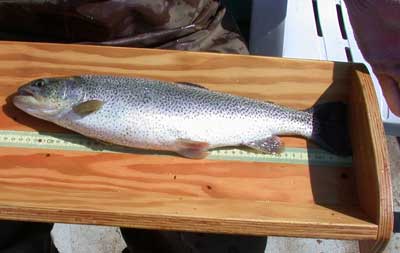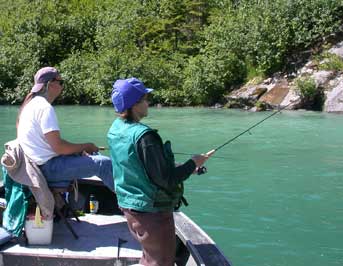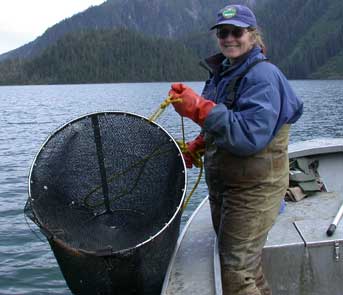Cutthroat Trout Research and Monitoring
 The overall objectives of this research program are to evaluate the sport fishing regulations and to monitor cutthroat trout populations throughout Southeast Alaska. Our research has focused on stock assessment, including estimation of abundance, annual survival, length/age composition, and sexual maturity schedules. The goal of current research projects is to develop non-lethal techniques for assessing maturity status and to better understanding the variability in length at maturity among cutthroat trout populations in Southeast Alaska.
The overall objectives of this research program are to evaluate the sport fishing regulations and to monitor cutthroat trout populations throughout Southeast Alaska. Our research has focused on stock assessment, including estimation of abundance, annual survival, length/age composition, and sexual maturity schedules. The goal of current research projects is to develop non-lethal techniques for assessing maturity status and to better understanding the variability in length at maturity among cutthroat trout populations in Southeast Alaska.
Some of the recent study sites include Auke, Baranof, Florence, Patching and Turner Lakes. Mark-recapture experiments have been periodically conducted on each of the lakes since 1994, with the exception of Patching Lake, which was first studied in 2005. Sampling is usually done over two trips, and is conducted by a two-person crew. Every fish is measured to the nearest mm, and cutthroat trout that are at least180 mm FL are marked with uniquely numbered T-bar or PIT tags (depending on the lake system). Samples are also secondarily marked to monitor for tag loss. Trout are captured with funnel traps, hoop traps or sport gear, depending on the lake system, in areas up to 50 m in depth. Data collection is somewhat different for each system, but in general, fish are inspected for previous tags or marks, and are measured from tip of the snout to the fork of the tail (nearest mm FL). Scale samples for age composition are taken, and if the fish is at least 180 mm FL and untagged, a uniquely numbered T-bar or PIT tag is inserted. If mortality occurs following tagging, otoliths are collected for aging, as well as length, scales, and sex information, and the T-bar or PIT tag is recovered.
 Auke Lake is located approximately 19.2 km north of Juneau, on the Juneau road system. It has a surface area of approximately 66.9 ha, and is fed by 5 tributaries. Auke Lake is 1.6 km long and 1.2 km wide with the greatest depth being 31.4 m. The elevation of the lake is approximately 19.1 m. The shoreline of Auke Lake is bordered by forested terrain, which varies from gentle slopes to steep-sided banks. Bait is prohibited here year-round, and high-use trout regulations are in effect (2 daily, 2 in possession, with 14-inch minimum and 22-inch maximum size limits).
Auke Lake is located approximately 19.2 km north of Juneau, on the Juneau road system. It has a surface area of approximately 66.9 ha, and is fed by 5 tributaries. Auke Lake is 1.6 km long and 1.2 km wide with the greatest depth being 31.4 m. The elevation of the lake is approximately 19.1 m. The shoreline of Auke Lake is bordered by forested terrain, which varies from gentle slopes to steep-sided banks. Bait is prohibited here year-round, and high-use trout regulations are in effect (2 daily, 2 in possession, with 14-inch minimum and 22-inch maximum size limits).
Turner Lake is located in the upper Taku Inlet, 26 km east of Juneau. The lake is 14 km long and has a surface elevation of just over 22 m. It is very steep-sided except near the inlet streams, covers about 1,270 ha, and has a maximum depth of 215 m. The lake outlet flows about 1,700 m to the Taku Inlet and is blocked to upstream fish passage by a barrier falls just below the lake. Turner Lake has a relatively small population of cutthroat trout, but it is a popular sport fishery in Southeast Alaska. Turner Lake is closed to the retention of cutthroat trout in the sport fishery. Anglers might be confused by the coloration of cutthroat trout in Turner Lake as some of the fish (particularly larger trout) are mostly silver with few spots. Anglers can rest assured that these fish are indeed cutthroat trout, as no other species of trout are found in the lake.
 Patching Lake is located in the Naha drainage on Revillagigedo Island, approximately 14 km upstream from Naha Bay. The lake is a narrow and steep sided, 5 km long, covers about 207 ha, with a mean depth of 30 m and a maximum depth of 67 m. Patching Lake is managed as a trophy lake, with a minimum size limit of 25” and a bag limit of 1 fish. Studies conducted in 2005 will allow for the estimation of abundance and length composition of cutthroat trout in Patching Lake.
Patching Lake is located in the Naha drainage on Revillagigedo Island, approximately 14 km upstream from Naha Bay. The lake is a narrow and steep sided, 5 km long, covers about 207 ha, with a mean depth of 30 m and a maximum depth of 67 m. Patching Lake is managed as a trophy lake, with a minimum size limit of 25” and a bag limit of 1 fish. Studies conducted in 2005 will allow for the estimation of abundance and length composition of cutthroat trout in Patching Lake.
Florence Lake lies approximately 50 km southwest of Juneau, on the west side of Admiralty Island. The 431 hectare lake is narrow (<1 km wide) and about 7.2 km long, with a maximum depth of approximately 27 m. Florence Lake has been a popular fly-in lake but logging in the area has reduced angler visits. The lake outlet flows about 1 km into Chatham Strait and passes over a barrier falls about 400 m upstream of tidewater, blocking the lake to anadromous species. Because a large population of cutthroat exists here, and fishing levels are minimal, regulations are more liberal. Five fish per day, and 10 in possession, of no size limit, are allowed, and bait can be used all year.
Baranof Lake is located 25 km east of Sitka on Baranof Island at the head of Warm Springs Bay. The lake is about 4.8 km long and 0.6 km wide, with a surface area of 324 ha, a maximum depth of 87 m, and a mean depth of 38 m. It has one major inlet (Baranof River), five minor tributaries, and a 0.4-km-long outlet which terminates in a 28-km barrier falls at the head of Warm Springs Bay. Baranof Lake is relatively unique among large lakes in Southeast Alaska in that it supports only one species of fish (i.e., only cutthroat trout) and that cutthroat trout have been caught in depths over 50 meters.
For additional information on these projects please contact: Roger Harding (907) 465-4311 Email (roger.harding@alaska.gov)
